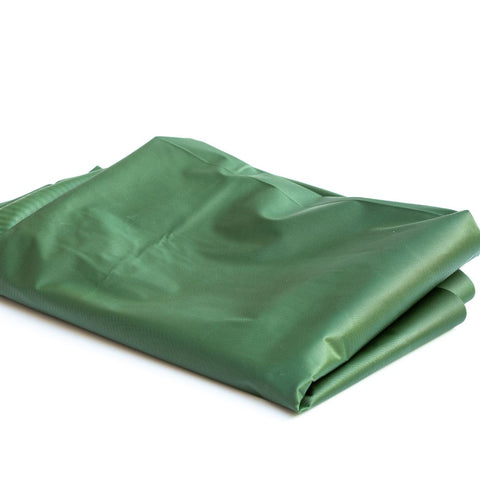When it comes to debris control on construction and demolition sites, choosing the right tarp can make the difference between a safe, compliant project and costly delays. The decision between mesh and solid tarps isn't just about budget—it's about understanding airflow dynamics, dust capture requirements, visibility needs, and safety implications for your specific application.
Understanding the Fundamentals: Airflow and Dust Particle Capture
Mesh Tarps: The Airflow Advantage

Mesh tarps are engineered with calculated perforations that allow controlled airflow while capturing larger debris particles. The key lies in understanding particle physics: larger debris (concrete chunks, wood pieces, metal fragments) lack the aerodynamic properties to pass through mesh openings, while air can flow freely.
This airflow characteristic serves multiple purposes:
-
Reduces wind loading on support structures by up to 70%
-
Prevents billowing that can stress mounting points
-
Maintains structural integrity during high-wind conditions
-
Allows natural ventilation that prevents moisture buildup
However, mesh tarps have limitations in dust particle capture. Fine particles under 500 microns can pass through standard mesh openings, making them unsuitable for applications requiring total dust containment.
Solid Tarps: Maximum Containment

Solid tarps create a complete barrier, capturing particles of all sizes from large debris down to fine dust. This total containment comes with trade-offs:
-
Higher wind resistance creates significant loading on support structures
-
Requires robust anchoring systems to prevent failure
-
May trap moisture leading to mold or material degradation
-
Creates pressure differentials that can affect structural stability
Visibility Requirements and Safety Implications

Mesh Tarps: Transparency Benefits
The semi-transparent nature of mesh tarps offers critical safety advantages:
-
Allows visual monitoring of work areas from outside the containment
-
Maintains situational awareness for crane operators and supervisors
-
Enables immediate identification of potential hazards
-
Facilitates emergency response by allowing visual assessment of conditions
Solid Tarps: Complete Privacy with Challenges
Solid tarps provide complete visual barriers, which can be advantageous for:
-
Sensitive demolition projects requiring privacy
-
Protecting proprietary processes from public view
-
Creating professional appearances for high-visibility locations
However, this opacity creates safety challenges:
-
Eliminates external monitoring capabilities
-
Requires additional safety protocols for worker supervision
-
May necessitate camera systems for remote monitoring
-
Can create blind spots for equipment operators
Applications for Different Demolition Methods

Interior Demolition: Mesh Tarp Advantages
For interior demolition work, mesh tarps excel because:
-
Dust levels are typically lower than exterior work
-
Airflow prevents heat buildup in enclosed spaces
-
Visibility allows coordination between multiple work crews
-
Reduced wind loading is less critical in protected environments
Best applications:
-
Kitchen and bathroom renovations
-
Office space reconfiguration
-
Retail store modifications
-
Residential interior updates
Exterior Demolition: Solid Tarp Necessity
Exterior demolition often requires solid tarps due to:
-
Higher dust generation from concrete and masonry
-
Environmental regulations requiring complete containment
-
Neighborhood considerations for dust and debris control
-
Weather protection for ongoing work
Best applications:
-
Building facade removal
-
Concrete structure demolition
-
Sandblasting operations
-
Hazardous material abatement
Selective Demolition: Hybrid Approaches
Many projects benefit from combining both tarp types:
-
Solid tarps on windward sides for maximum dust control
-
Mesh tarps on leeward sides for airflow and visibility
-
Solid tarps at dust generation points with mesh elsewhere
-
Seasonal adjustments based on weather patterns
Mechanical Demolition Considerations
High-Impact Operations
Excavator and wrecking ball operations generate significant debris with high kinetic energy. Mesh tarps must be sized appropriately—typically 12-gauge or heavier—to contain these projectiles while maintaining structural integrity.
Precision Demolition
Controlled demolition using specialized tools produces more predictable debris patterns. This allows for optimized tarp selection based on anticipated particle sizes and distribution patterns.
Environmental and Regulatory Factors
Air Quality Compliance
Many jurisdictions require specific dust containment measures. Understanding local regulations helps determine when solid tarps are mandatory versus when mesh tarps meet compliance requirements.
Stormwater Management
Solid tarps can redirect water flow, potentially creating drainage issues. Mesh tarps allow natural water passage while still providing debris containment.
Making the Right Choice
The decision between mesh and solid tarps should consider:
-
Primary containment goal: Large debris vs. fine dust
-
Environmental conditions: Wind exposure and weather patterns
-
Regulatory requirements: Local dust control mandates
-
Safety protocols: Visibility and monitoring needs
-
Project duration: Long-term vs. short-term installations
-
Budget constraints: Material and installation costs
Conclusion
Successful debris control isn't about choosing the most expensive or heavy-duty option—it's about matching tarp characteristics to specific project requirements. Mesh tarps offer superior airflow management and visibility for many applications, while solid tarps provide unmatched containment for dust-sensitive environments.
Whether you're managing a small renovation or a large-scale demolition project, understanding these fundamental differences ensures you select the right containment solution for safety, compliance, and cost-effectiveness.
For expert guidance on selecting the optimal tarp solution for your specific application, trust the professionals at Tarp Supply Inc.® Our experienced team can help you navigate the technical requirements and regulatory considerations to ensure your project succeeds safely and efficiently.





